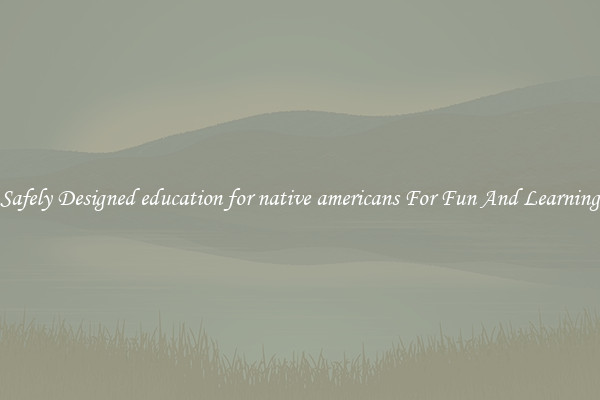Safely Designed education for native americans For Fun And Learning
Safely Designed Education for Native Americans: Fun and Learning

Education plays a vital role in shaping the future of individuals and communities. However, it is essential to ensure that education is not only accessible but also culturally relevant and safe for all students. This is particularly true for Native American students, who have unique histories, cultures, and educational needs. Safely designed education for Native Americans aims to provide an inclusive, enjoyable, and enriching learning experience for these students.
One of the critical aspects of safely designed education for Native Americans is creating a safe and supportive learning environment. Native American students must feel comfortable and accepted in their educational settings. This can be achieved by incorporating Indigenous culture and history into the curriculum, ensuring that relevant and accurate information is shared. By acknowledging and valuing Native American traditions, languages, and knowledge systems, educators can create an educational space that nurtures the students' identity and self-worth.
In addition to cultural inclusion, safety measures must be implemented to create an environment free from discrimination, bullying, and violence. Native American students often face higher rates of harassment and discrimination due to stereotypes and misunderstandings. By actively promoting cultural sensitivity and embracing diversity, educational institutions can help eliminate these barriers. Comprehensive anti-bullying programs, cultural competency training for staff, and the establishment of student support networks can significantly contribute to ensuring the safety and well-being of Native American students.
Another vital aspect of safely designed education for Native Americans is the inclusion of hands-on and fun learning experiences. Native American cultures have a long history of oral tradition and interactive learning methods. Therefore, incorporating activities that encourage student engagement, critical thinking, and creativity is essential. This can include storytelling, art projects, traditional games, and outdoor learning experiences that connect students to their cultural heritage while fostering a love for learning.
Moreover, safely designed education for Native Americans should incorporate community involvement. Native American communities play a significant role in the educational journey of their students. Engaging parents, elders, and community leaders in the educational process can strengthen family-school partnerships and enhance understanding and support for Native American students. This can be achieved through regular communication, cultural events, and the inclusion of community representatives in decision-making processes.
In conclusion, safely designed education for Native Americans is crucial in providing inclusive and engaging learning experiences. By creating a safe and culturally relevant environment, incorporating fun and interactive learning techniques, and fostering community involvement, we can ensure that Native American students receive an education that acknowledges their unique identities and prepares them for a bright future. Through these efforts, we can empower Native American students to proudly embrace their heritage while fostering a love for learning.

View details

View details

View details

View details








